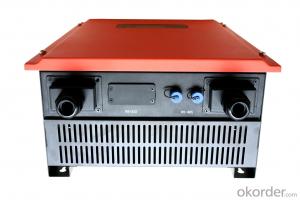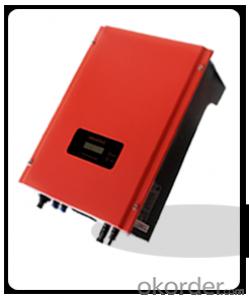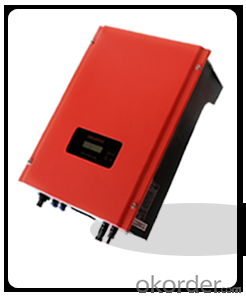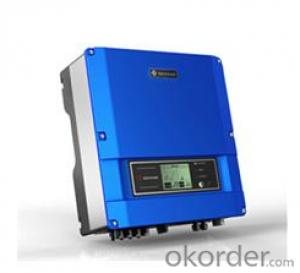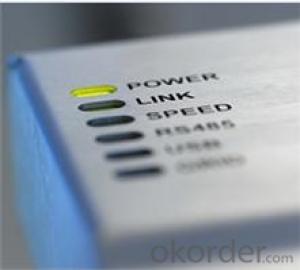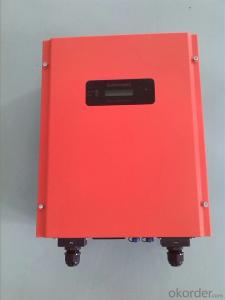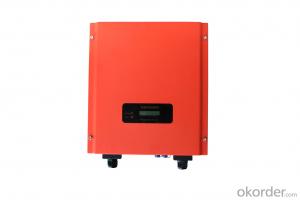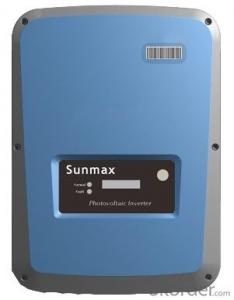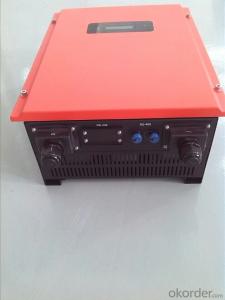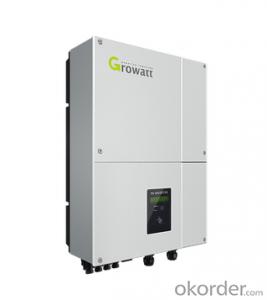Fusion Solar Inverter Sunteams 3600-5000 PV
- Loading Port:
- Shanghai
- Payment Terms:
- TT OR LC
- Min Order Qty:
- 5 watt
- Supply Capability:
- 3000 watt/month
OKorder Service Pledge
OKorder Financial Service
You Might Also Like
The Sunteams 1500 ~5000 series is applicable to various rooftops and small scale photovoltaic grid-connected power plants. Their nominal output powers are 1.5 kW, 2 kW, 2.5 kW,
3 kW, 3.6 kW, 4 kW and 5kW respectively.
This series is transformerless and has a wide range of MPPT input voltage. Its maximum conversion efficiency and MPPT tracking accuracy reach 97.6 % and 99.5 % respectively. The maximum DC voltage reaches 550 V. Its multilingual LCD display facilitates easy operation. It has waterproof direct plug-in terminals. It has overvoltage, islanding, short-circuit, overloading and overheating protection functions. Its IP65 protection degree will ensure it runs well in various tough environments
Efficient
■ The maximum efficiency of the inverter can reach 96.5 % - 97.6 %
■ Transformerless design
Flexible
■ For indoor and outdoor installation
■ Maintenance free
Simple
■ ‘Plug and play’connection for easy installation
■ Designed for hanging with simple and easy installation
Communicative
■ RS232 / RS485 interfaces as standard
■ Optional Bluetooth technology
- Q: Can a solar inverter be used in systems with different module capacities?
- Yes, a solar inverter can be used in systems with different module capacities. Solar inverters are designed to convert the DC power generated by solar modules into AC power for use in homes or businesses. They are typically flexible and compatible with a wide range of module capacities, allowing them to be used in systems with varying sizes and configurations. However, it is important to ensure that the inverter's capacity matches or exceeds the total capacity of the connected solar modules to ensure optimal performance and efficiency.
- Q: What is the role of a solar inverter in grid management and stability?
- The role of a solar inverter in grid management and stability is crucial in integrating solar power into the existing electrical grid system. Solar inverters are responsible for converting the direct current (DC) electricity generated by solar panels into alternating current (AC) electricity that can be used by homes and businesses or fed back into the grid. In terms of grid management, solar inverters play a vital role in maintaining the stability and reliability of the electrical grid. They provide grid support functions such as voltage regulation, frequency control, and reactive power compensation. By monitoring the grid conditions and adjusting the output of solar power accordingly, inverters help to balance the supply and demand of electricity in real-time, ensuring grid stability. Solar inverters also contribute to grid stability by improving power quality. They actively filter out harmonics, voltage fluctuations, and other electrical disturbances that can be caused by the intermittent nature of solar power generation. This ensures that the electricity generated by solar panels is of high quality and does not introduce any disruptions or damage to the electrical grid. Furthermore, solar inverters enable the seamless integration of solar power into the grid, allowing excess energy to be fed back into the system. This is known as net metering or feed-in tariff programs, where solar energy producers can receive compensation for the surplus electricity they produce. With the help of inverters, the generated solar energy can be efficiently transferred to the grid, reducing the reliance on traditional fossil fuel-based power generation and promoting renewable energy integration. Overall, the role of a solar inverter in grid management and stability is to ensure the smooth integration and optimal utilization of solar power, while maintaining the stability, reliability, and quality of the electrical grid. It acts as a bridge between solar energy producers and the grid, facilitating the efficient and sustainable integration of renewable energy sources into the existing power infrastructure.
- Q: Can a solar inverter be used in regions with high levels of electromagnetic interference?
- Yes, a solar inverter can be used in regions with high levels of electromagnetic interference. However, it is important to ensure that the solar inverter is designed and manufactured to have proper electromagnetic compatibility (EMC) measures in place. These measures help to minimize the impact of electromagnetic interference on the operation and performance of the solar inverter.
- Q: What are the safety features of a solar inverter?
- The safety features of a solar inverter typically include surge protection, overvoltage protection, short circuit protection, ground fault detection, and overtemperature protection. These features help to prevent damage to the inverter and the electrical system, ensuring safe and reliable operation.
- Q: How do you size a solar inverter for a solar power system?
- To size a solar inverter for a solar power system, you need to consider the maximum power output of the solar panels and the total load you want to power. The inverter's capacity should be equal to or greater than the total power output of the solar panels to ensure efficient energy conversion. Additionally, you should also consider the voltage and current requirements of the load to ensure compatibility with the inverter. It is recommended to consult with a professional or use online sizing tools to accurately determine the appropriate inverter size for your specific solar power system.
- Q: How does a solar inverter interact with a battery storage system?
- A solar inverter interacts with a battery storage system by converting the direct current (DC) electricity generated by the solar panels into alternating current (AC) electricity that can be used to power homes and businesses. It also manages the flow of electricity between the solar panels, the battery storage system, and the electrical grid. When the solar panels produce more electricity than is being used, the excess energy is stored in the battery system for later use. Conversely, when the solar panels do not generate enough electricity to meet the demand, the inverter draws power from the battery storage system to supplement the shortfall. This interaction ensures a continuous and reliable power supply from solar energy, even during periods of low sunlight or high energy demands.
- Q: How does MPPT improve the efficiency of a solar inverter?
- MPPT, or Maximum Power Point Tracking, improves the efficiency of a solar inverter by constantly adjusting the operating point of the solar panel to extract maximum power from the sunlight. It ensures that the solar panel operates at its maximum power point, regardless of changing weather conditions or variations in the solar irradiance. This optimization leads to higher energy conversion efficiency, maximizing the power output of the solar panel and ultimately increasing the overall efficiency of the solar inverter.
- Q: What is the role of a solar inverter in preventing electrical hazards?
- The role of a solar inverter in preventing electrical hazards is to convert the direct current (DC) electricity produced by solar panels into alternating current (AC) electricity that can be safely used in homes or businesses. It ensures that the electrical output from the solar panels is compatible with the electrical grid, reducing the risk of overloading or short circuits that can lead to electrical hazards such as fires or electrocution. Additionally, solar inverters have built-in safety features like ground fault protection and rapid shutdown mechanisms, which further minimize the chances of electrical accidents.
- Q: Can a solar inverter be used with a solar-powered waste management system?
- Yes, a solar inverter can be used with a solar-powered waste management system. A solar inverter is responsible for converting the direct current (DC) electricity produced by solar panels into alternating current (AC) electricity that can be used by electrical appliances and systems. In the case of a solar-powered waste management system, the solar inverter would convert the DC electricity generated by the solar panels into AC electricity, which can then power the various components of the waste management system such as motors, sensors, and controls. This ensures that the waste management system operates efficiently and effectively using renewable solar energy.
- Q: How does a solar inverter handle partial shading on solar panels?
- A solar inverter handles partial shading on solar panels by utilizing a technique called Maximum Power Point Tracking (MPPT). MPPT allows the inverter to constantly monitor and adjust the voltage and current levels of each solar panel to ensure that it operates at its maximum power output despite shading. This is achieved by dynamically redistributing power between the shaded and unshaded panels, optimizing the overall energy generation of the entire solar array.
Send your message to us
Fusion Solar Inverter Sunteams 3600-5000 PV
- Loading Port:
- Shanghai
- Payment Terms:
- TT OR LC
- Min Order Qty:
- 5 watt
- Supply Capability:
- 3000 watt/month
OKorder Service Pledge
OKorder Financial Service
Similar products
Hot products
Hot Searches
Related keywords

